Guest post by Priya Desai
Background
This was organised by the Ashoka Trust for Research in Ecology and the Environment (ATREE). Held on May 26th 2011, we were joined by around 150 to 200 student volunteers from various higher educational institutions in Kerala, such as the Kerala University of Fisheries and Ocean Studies, St. Albert's College in Ernakulam, School of Applied Life Sciences in Chuttippara and the School of Environmental Sciences, Mahatma Gandhi University.
The event was also supported by various other stakeholders, such as the Kerala State Biodiversity Board, the Vembanad Nature Club, the Regional Agricultural Research Station in Kumarakom, the Conservation Research Group of Kerala and the Kayal Samrakshna Samithys around Vembanad.
About Lake Vembanad
The Vembanad wetlands foster high biodiversity in the backwaters of Alleppey and substantially support the livelihoods of fishermen and paddy cultivators in the area. Vembanad is the largest wetland system in India, covering an area of over 2,000 square kilometres. It is bordered by Alleppey, Ernakulam and Kottayam districts and lies at sea level, separated from the Arabian Sea by a narrow barrier island. It is approximately 14 kilometres wide at its widest point, and has the distinction of being India's longest lake at just over 96.5 kilometres in length.
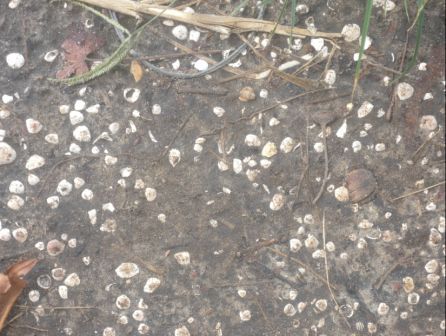
Shells on the lake bed walking through the backwaters: Vembanad Lake flows into the Arabian Sea
Unfortunately, the environmental conditions of Vembanad Lake have steadily declined in recent years primarily due to human activities, resulting in a crisis for communities that are dependent on the lake for their livelihoods. Fisherfolk are the primary stakeholders at Vembanad Lake and have always been actively involved in conservation efforts and the management of the resources they rely on every day. Today, tourism is a huge source of income at Lake Vembanad thanks to the idyllic backwaters. Houseboats are by the dozen, even causing traffic jams, and tourists have little or no ownership of the area to keep it clean. While people are willing to pay serious money to come to this part of Kerala and drift along the idyllic backwaters in the name of “ecotourism”, the relentless increase in the number of houseboats and the tourists that use them simply exacerbates the ecological threat to the lake.
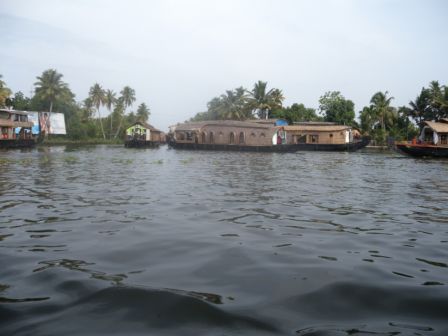
Houseboat traffic jam on the backwaters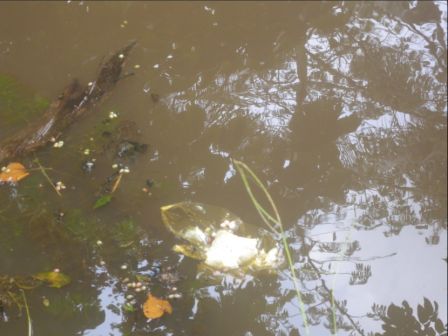
Litter and garbage around houseboats parked on the backwaters
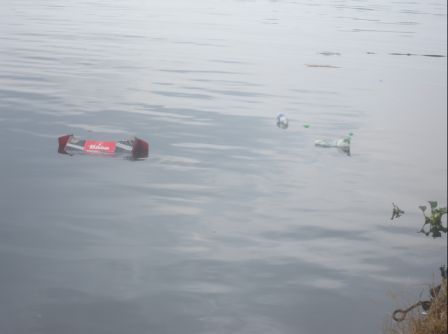
Litter and garbage around houseboats parked on the backwaters
Other causes for the Vembanad ecosystem's declining health are the obstruction of river courses, sand mining and habitat destruction, loss of riparian canopy cover, encroachment, pollution and unethical fishing practices.
Vembanad Lake is also facing ecological problems due to the rampant propagation of water hyacinth, an aggressive plant that spreads over the surface of the lake, covering large areas of water and thus depleting oxygen and sunlight. Other plants and vegetation die due to lack of sunlight, while fish and other aquatic life forms die due to lack of oxygen. Water hyacinth is considered by some to be nothing more than a pest plant; it has little or no known nutritional value to wildlife or aquatic ecosystems.
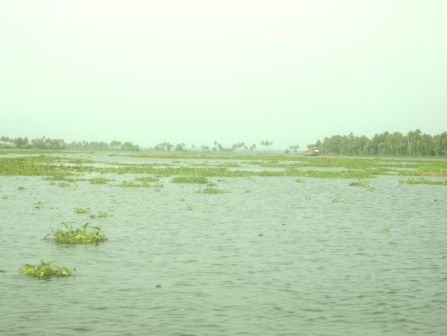
Water hyacinth covers the backwaters
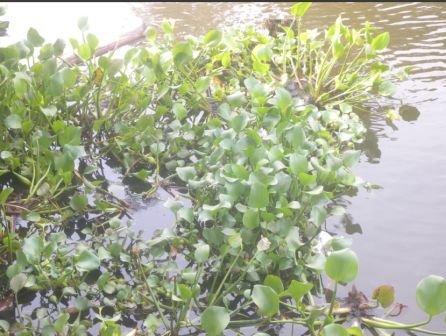
Water hyacinth covers the backwaters
Another notable conflict of interest has arisen from the fact that vast areas of paddy fields have been reclaimed on Vembanad Lake. Since Vembanad flows into the ocean, a narrow barrage has been constructed to regulate the flow of freshwater from the lake into the sea and vice versa. The authorities in the area seem to favour the paddy cultivators by keeping the shutters of the barrage closed so saline water doesn't flow into the lake. This benefits the paddy farmers but does not benefit the fisherfolk, who are the original community that depended on the lake for their livelihoods. The more saline water that flows into Vembanad, the better it is for the diversity of fish in the lake; now there is an unfortunate conflict of interest between the two livelihoods.
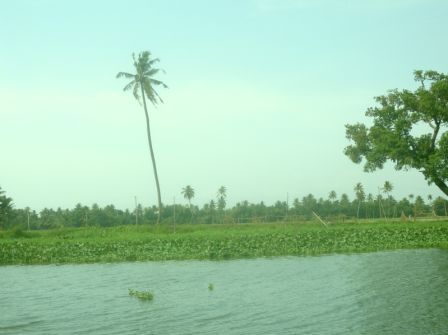
Paddy fields on vast areas of reclaimed land on Vembanad Lake
The Event: Vembanad Fish Count 2011
The 4th edition of the Vembanad Fish Count aimed to recapture the participatory approach adopted in earlier editions of the event, to enhance cooperation between various stakeholders, government departments, NGOs and academic institutions. The fish count is an attempt to facilitate a deliberative, democratic conservation strategy for Vembanad Lake to ensure maximum participation from the communities that depend on it, and to spread awareness about the problems facing this beautiful product of nature.
The primary objective of this year's fish count was to inventorise the diversity and richness of fish species in the lake. An orientation was held the evening before the event itself, dividing the student volunteers into 4 survey groups. Each group was assigned to one boat, and each was accompanied by a team of scientists and experts coordinated by ATREE. Each boat departed at 6 a.m. from their assigned locations; the boat that the Arghyam team was on left from Alleppey.
Our boat found close to 9 different species of fish, some of which are pictured below. Most of the big freshwater fish were found on other boats that left from other locations; however it was interesting to note the diversity of fish in spite of the declining ecology in the area, and the everyday routine of the fishermen who accompanied us on the fish count.
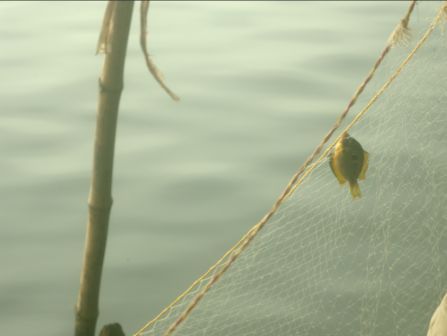
Etroplus maculatus (common name: Orange Chromide)
Volunteers helping the fisherman count fish at first landing centre
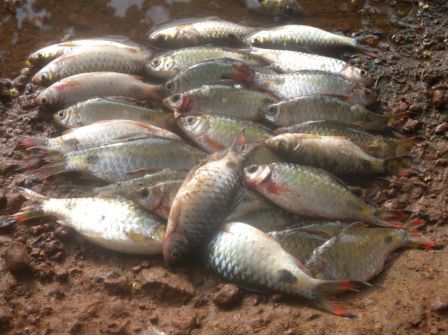
Puntius filamentosus (commonly known as Filamentous barb or DMK barb)
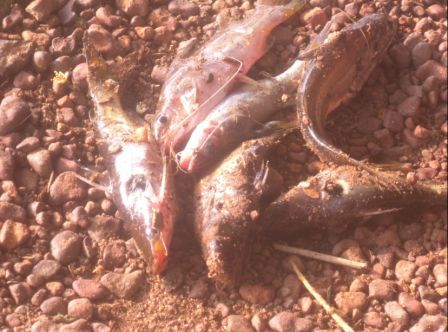
Horabagrus brachysoma (common name: Asian Sun Catfish)
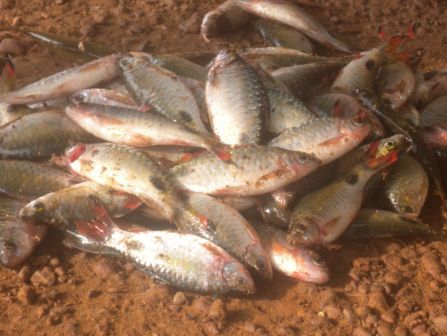
Puntius filamentosus (commonly known as Filamentous barb or DMK barb)
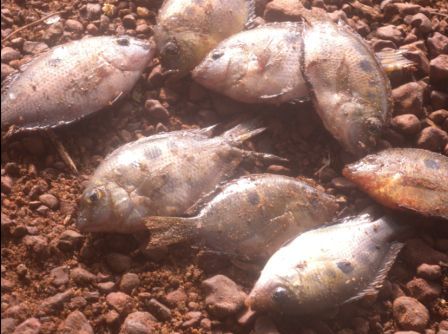
Results of the Fish Count
The 4th edition of the Vembanad Fish Count revealed an alarming fall in aquatic life. In total, the count found 45 species of fin fish and 9 species of crustaceans and molluscs, including shrimp. This is the lowest figure ever recorded since the Vembanad Fish Count was initiated in 2008. The main causes for the declining figures were the lack of salinity in the lake water, owing to the irregular operation of the shutters of the Thanneermukkom barrage between Lake Vembanad and the Arabian Sea. Because of this, Vembanad Lake now only has one freshwater fish species. In addition to less salinity, the increasing pollution and other factors discussed earlier in this article, such as the growth of water hyacinth and the conflict of interest between the paddy farmers and fishermen, are all collectively responsible for the decline in numbers of fish species at Vembanad Lake this year.